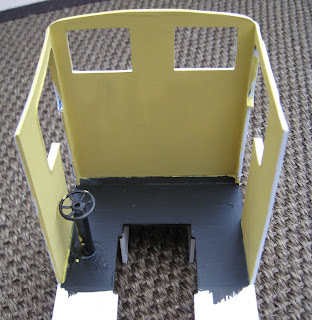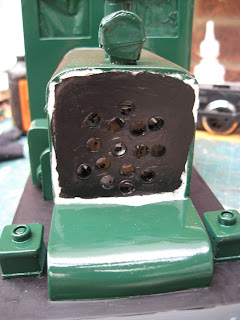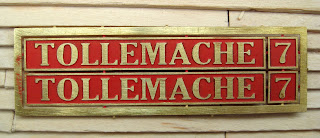A mainstay of the Peckforton Railway has been the diesel loco which hauls the tippler wagons from the copper mine to the mainline interchange sidings at Beeston Market. This job has been manfully handled for the past four years by an 0-4-0 ToyTrain diesel loco. This has always been a stop-gap measure until something more appropriate could be found or constructed.
After some deliberation and a fair amount of online research I decided that the ToyTrain diesel wasn't too dissimilar to an early standard gauge Fowler.
Fowler did produce a small number of narrow gauge diesels. I'm not sure if they adapted their standard gauge design for three foot gauge. It seems there was a 2-4-0 three foot gauge Fowler diesel loco at the Harbury Cement Works, but I've not yet tracked down an 0-4-0 three foot gauge prototype. My model would therefore be such a special order. All that was required was some judicious bashing of the ToyTrain,
The first job was to disassemble the loco. The four screws fixing the sides of the body to the chassis were removed:
together with the two screws holding the front of the chassis to the body:
Once the wires connecting the headlight to the chassis had been unplugged, the 0-4-0 Toytrain chassis was revealed
This was completely dismantled and all excess mouldings were carefully sawn off the main chassis block
The principal difference between the ToyTrain diesel and the Fowler chassis is the layshaft and fly-cranks which are connected to the driving wheels by a connecting rod. The sub-chassis needed to be extended in some way to provide somewhere to mount this additional mechanism.
A saddle was bent from 0.064" x 0.5" brass
This was drilled to take the layshaft and then attached to the footplate with a couple of self tapping screws.
I tried fashioning some fly-cranks from brass but was not really happy with them.
Some whitemetal cranks were bought from Garden Railway Specialists, but the distance between the crank and the centre bearing was around 1mm too short. I decided this could be accommodated if I slotted the bearings in the connecting rods.
These were fashioned from another piece of 0.064" brass. To provide more clearance for the fly cranks, another wider 'saddle' was fashioned and screwed to the chassis block.
Self-tapping screws with integral washers (salvaged from an old cassette player) were used to join the connecting rods to the fly cranks, which were quartered and Superglued to the layshaft.
The chassis was then tested. There was some sloppiness in the connecting rods owing to the slotted bearings, but otherwise it ran sufficiently smoothly for me to consider making the body.
The first task was to make the footplate, from a piece of 200mm x 95mm x 2mm thick plasticard,
To this were glued two 95mm x 25mm buffer beams, again cut from 2mm thick plasticard.
Next, two 75mm wide x 95mm tall pieces of 2mm thick plasticard were cut for the cab sides. The openings were marked out and 10mm holes drilled for the radiused corners.
using a wood drill, the point enabling the drill to be positioned accurately (5mm in from each corner).
The opening was then cut out and filed to smooth off any inconsistencies.
A 3mm wide strip of 1mm thick plasticard was cut.
and then glued round the opening, being pushed into the corners with the end of a paint brush.
When the glued had set..............
.................. the excess was trimmed off
Then two pieces of 91mm wide x 95mm tall plasticard were marked out for the ends. The roof of the ToyTrain diesel was used as a template for the curvature of the roof.
These were then cut out as were two 27mm x 22mm windows.
Inside the front of the cab, a control panel was made, This was also made to accommodate the chassis block and provided sufficient space for the weights and the decoder. I had no idea what the inside of a Fowler diesel looks like so used my imagination and a bit of guesswork.
Next, I turned my attention to the bonnet. Again, I consulted the photos of the original and produced something which looked about right, although my model was foreshortened to match the footplate. The dimensions were 85mm long x 55mm wide and 60mm high. The front panel was curved at the top, using a Humbrol paint tin as the template.
The top of the bonnet was then formed with a series of 2mm thick plasticard steps.
These were then filed to match the contour of the curve on the front panel.
The gaps were then plugged with filler which was sanded smooth once set.
The bonnet was then attached to the front of the cab and holes drilled in the front of the bonnet to accommodate the 49mm diameter speaker for the sound decoder.
Some whitemetal fittings for the inside of the cab were bought from Garden Railway Specialists as part of their diesel detailing pack. Again, not knowing what the inside of the cab would look like, I stuck the fittings where seemed most appropriate.
The speaker was fixed in place in the front of the bonnet, being held in place by a piece of plasticard glued behind the speaker to trap it in place.
The sound decoder (an MRC AD322) was place under the top of the bonnet and, as with the speaker, held in place by a couple of plasticard strips glued across beneath it. The speaker wires being soldered during the process.
The radiator was next constructed. The front of the radiator was marked out...............
.............. and 6mm holes drilled in the corners of the grille opening.........
...... before being cut out and smoothed off with a needle file.
The top of the radiator was thickened by gluing two pieces of 2mm thick plasticard behind it, then 3mm high Slaters letters were fixed to the front of the radiator showing the maker's name.
4mm wide strips of 1mm thick plasticard were glued to the sides of the radiator and thin strips were glued horizontally at 10mm intervals. A 5mm wide strip of 0.5mm thick plasticard was glued across the top of the radiator.
A piece of aluminium mesh was trimmed to size and then glued in place to represent the radiator grille.
Pieces of redundant lead flashing were cut to size and fitted inside the bonnet.
These were held in place with a couple of strips of plasticard.
The rear and the sides of the cab were then glued to the footplate and blanking pieces were cut out and glued beneath the footplate to fill the gaps between the chassis block and the buffer beams.
Steps were also fixed in place beneath the cab openings - 24mm x 24mm. These were over-engineered to help survive inevitable knocks.
Sand boxes were constructed from four pieces of 1mm thick plasticard with a 2mm thick lid.The boxes were 10mm x 15mm x 10mm high.
The caps for the boxes were made from the ends of cheap plastic ballpoint pens.
I decided to construct a representation of the air tanks, though these only seemed to appear on some versions of the original. Although none of my stock is vacuum-braked, I assume the loco will be. The main housing was constructed from to pieces of 1mm thick plasticard, cut to 30mm x 10mm and then rounded at the top. A strip of 15mm wide 0.5mm thick plasticard was then glued to the two side pieces and trimmed off at the base.
A strip of 8mm wide louvres from Cambrian Models was glued to the side and the top of a cheap ballpoint pen was sliced off and glued to one side to represent the end of the air pump. A further chunk of plasticard was added to represent another bit of this mechanism. On reflection, this housing needed to be shorter and fatter, but as everything on my model is foreshortened I decided to exercise modeller's licence. 18mm tall louvres (again from Cambrian) were added to each side of the bonnet.
The 25mm tall chimney was constructed from the barrel of another cheap ballpoint pen with layers of plasticard wrapped around the top.
Some filler was applied and then smoothed down with emery paper. Again, on reflection this should have been taller (ie 35mm) to clear the top of the cab.
The headlight from the ToyTrain diesel was fixed to the front of the bonnet and wired into the decoder.
Before all the various components were assembled, the inside of the cab was painted with acrylics.
I went for chocolate and cream as the default colour, assuming this would probably be the preference for the period of manufacture (1920s).
... and the chassis and motion was painted with black acrylics.
The cowl for the gearbox at the front of the loco was constructed in the same way as the cover for air tanks.
Then all the various sections were assembled and the openings to the cab, the windows and the front of the bonnet were masked off before the whole lot was sprayed with Halfords grey primer.
as was the radiator.
Two coats of primer were applied. Some slight dints and blemishes were filled and sanded between coats. Then two coats of Humbrol Brunswick Green acrylic were applied from a warmed rattle can.
When the green paint had dried, the masking tape was removed from the footplate, which was then hand-painted with black acrylics.........
......... as was the front of the bonnet, housing the loudspeaker.
The radiator was sprayed separately...........
........... and when dry a piece of black cloth (from an old (washed) sock), was trimmed to fit behind the grille and held in place with a few dabs of superglue.
The radiator was then glued into place and touched up in places.
The radiator cap was made from a piece of tubing (one of the mounts from the ToyTrain roof) and a self-tapping screw.
Some filler was applied to disguise the slot, then smoothed down with some fine emery and painted 'brass'.
The roof of the ToyTrain diesel was trimmed to size and mounted on the cab. This will be fixed in place with clear adhesive, to enable easy removal for detailing etc.
Number and nameplates were ordered from Narrow Planet. These are batch processed and so may take a while to be delivered depending on how many have already been ordered - however they are very reasonably priced and well worth the wait.
I had decided to name this loco in honour of the local landowner who, in my hypothetical history, was largely responsible for financing the railway. Unfortunately, when the nameplates arrived I realised they were slightly over-sized. My own fault as Steve at Narrow Planet allows you to specify the exact size required and sends the artwork for approval before they are etched. Another set were ordered which Steve kindly volunteered to replace for free - even though it was my mistake! Just another example of how supportive fellow modellers are in this hobby!!
Once the paint had dried and hardened sufficiently well, it was lined using Trimline tape (see How I lined locos with Trimline tape)
The loco needed to be tested, of course. So an opportunity arose for me to try out the recently weathered rake of LGB tipplers (see How I created a rake of loaded, weathered LGB tipplers)
Update Sept 2015
As part of the conversion of my railway from track-power to battery powered radio control, I converted the loco to battery power - see How I converted my Fowler diesel to battery powered radio control and installed a sound system from Technobots (see How I control a Technobots programmable soundcard with Deltang/RC Trains equipment)










































































7 comments:
Rik that is looking wonderful - a real credit to your scratchbuilding skills!
Thanks James. My first attempt at scratchbuilding a loco body. I thought a diesel might be easier than a steam loco. It seems to have worked out OK as long as we don't look too closely.
Rik
Great work Rik. It's good of you to take the time to document all the steps so we can all get your tips. I specially liked your method for the drive shaft.
love it Rick - nice work, you really captured the feel of theloco.
NHN
Thanks guys. Not based on a particular prototype, but 'inspired' by the early Fowler diesel mechanicals. One good reason for building a hypothetical narrow gauge railway is having the freedom to build and run whatever you feel is appropriate. Real NG railways borrowed, bought and occasionally rebuilt stock from other railways.
Rik, just stumbled on this site from your YouTube NG videos - the Fowler diesel is excellent and really captured the look of a Fowler, especially the cab and bonnet front, well done.
Stanthesteam
Thanks Stan
As you can see, I just used a photo of a standard gauge Fowler from about the right period to guide the build. I felt a 3' gauge version would be more likely to based on a standard gauge model than their 2' narrow gauge models. I tried looking for a 3' gauged Fowler and although I found out that they did manufacture them, I couldn't find a picture or drawing of one. Hence the 'inspired-by' tag I've used for this model.
Post a Comment